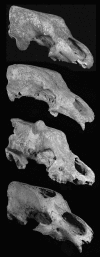Isotopic evidence for omnivory among European cave bears: Late Pleistocene Ursus spelaeus from the Peştera cu Oase, Romania
- PMID: 18187577
- PMCID: PMC2206582
- DOI: 10.1073/pnas.0711063105
Isotopic evidence for omnivory among European cave bears: Late Pleistocene Ursus spelaeus from the Peştera cu Oase, Romania
Abstract
Previous bone collagen carbon and nitrogen isotopic studies of Late Pleistocene European cave bears (Ursus spelaeus) have shown that these bears frequently had low nitrogen isotope values, similar to those of herbivores and indicating either unusual physiology related to hibernation or a herbivorous diet. Isotopic analysis of animal bone from the Peştera cu Oase (Cave with Bones), Romania, shows that most of its cave bears had higher nitrogen isotope values than the associated herbivores and were, therefore, omnivorous. The Oase bears are securely identified as cave bears by both their morphology and DNA sequences. Although many cave bear populations may have behaved like herbivores, the Oase isotopic data demonstrate that cave bears were capable of altering their diets to become omnivores or even carnivores. These data therefore broaden the dietary profile of U. spelaeus and raise questions about the nature of the carnivore guild in Pleistocene Europe.
Conflict of interest statement
The authors declare no conflict of interest.
Figures



Comment in
-
Hibernation can also cause high delta15N values in cave bears: a response to Richards et al.Proc Natl Acad Sci U S A. 2008 Mar 18;105(11):E14; author reply E15. doi: 10.1073/pnas.0800915105. Epub 2008 Mar 6. Proc Natl Acad Sci U S A. 2008. PMID: 18326029 Free PMC article. No abstract available.
Similar articles
-
Predormancy omnivory in European cave bears evidenced by a dental microwear analysis of Ursus spelaeus from Goyet, Belgium.Proc Natl Acad Sci U S A. 2009 Sep 8;106(36):15390-3. doi: 10.1073/pnas.0907373106. Epub 2009 Aug 24. Proc Natl Acad Sci U S A. 2009. PMID: 19706401 Free PMC article.
-
Pitfalls in comparing modern hair and fossil bone collagen C and N isotopic data to reconstruct ancient diets: a case study with cave bears (Ursus spelaeus).Isotopes Environ Health Stud. 2014;50(3):291-9. doi: 10.1080/10256016.2014.890193. Epub 2014 Mar 3. Isotopes Environ Health Stud. 2014. PMID: 24588112
-
Microwear and isotopic analyses on cave bear remains from Toll Cave reveal both short-term and long-term dietary habits.Sci Rep. 2019 Apr 5;9(1):5716. doi: 10.1038/s41598-019-42152-7. Sci Rep. 2019. PMID: 30952915 Free PMC article.
-
Ursus spelaeus (Rosenmüller, 1794) during the MIS 3: new evidence from the Cioclovina Uscată Cave and radiocarbon age overview for the Carpathians.Isotopes Environ Health Stud. 2025 Mar;61(1):101-113. doi: 10.1080/10256016.2024.2376730. Epub 2024 Jul 24. Isotopes Environ Health Stud. 2025. PMID: 39049521
-
Stable isotopes data (delta13C, delta15N) from the cave bear (Ursus spelaeus): a new approach to its palaeoenvironment and dormancy.Proc Biol Sci. 2001 Jun 7;268(1472):1159-64. doi: 10.1098/rspb.2001.1639. Proc Biol Sci. 2001. PMID: 11375104 Free PMC article.
Cited by
-
Fate and preservation of the late pleistocene cave bears from Niedźwiedzia Cave in Poland, through taphonomy, pathology, and geochemistry.Sci Rep. 2024 Apr 29;14(1):9775. doi: 10.1038/s41598-024-60222-3. Sci Rep. 2024. PMID: 38684693 Free PMC article.
-
The effect of body size evolution and ecology on encephalization in cave bears and extant relatives.BMC Evol Biol. 2017 Jun 5;17(1):124. doi: 10.1186/s12862-017-0976-1. BMC Evol Biol. 2017. PMID: 28583080 Free PMC article.
-
Retreat and extinction of the Late Pleistocene cave bear (Ursus spelaeus sensu lato).Naturwissenschaften. 2016 Dec;103(11-12):92. doi: 10.1007/s00114-016-1414-8. Epub 2016 Oct 11. Naturwissenschaften. 2016. PMID: 27730265 Free PMC article.
-
Neanderthals on the Lower Danube: Middle Palaeolithic evidence in the Danube Gorges of the Balkans.J Quat Sci. 2022 Feb;37(2):142-180. doi: 10.1002/jqs.3354. Epub 2021 Aug 25. J Quat Sci. 2022. PMID: 35874300 Free PMC article.
-
Predormancy omnivory in European cave bears evidenced by a dental microwear analysis of Ursus spelaeus from Goyet, Belgium.Proc Natl Acad Sci U S A. 2009 Sep 8;106(36):15390-3. doi: 10.1073/pnas.0907373106. Epub 2009 Aug 24. Proc Natl Acad Sci U S A. 2009. PMID: 19706401 Free PMC article.
References
-
- Kurtén B. The Cave Bear Story. New York: Columbia Univ Press; 1976.
-
- Mattson DJ. Diet and morphology of extant and recently extinct northern bears. Ursus. 1998;10:479–496.
-
- Rabeder G, Nagel D, Pacher M. Der Höhlenbär. Stuttgart: Thorbecke; 2000.
-
- Grandal A, López F. Sexual dimorphism and autogenetic variation in the skull of the cave bear (Ursus spelaeus Rosenmüller) of the European Upper Pleistocene. Geobios. 2005;38:325–338.
-
- Vila M, Fernández D, López F, Grandal A, Vidal JR. Paleoecological implications inferred from stable isotopic signatures (δ13C, δ15N) in bone collagen of Ursus spelaeus ROS.-HEIN. Cab Lab Xeol Laxe. 1999;24:73–87.
Publication types
MeSH terms
Substances
Associated data
- Actions
- Actions
- Actions
- Actions
- Actions
- Actions
- Actions
- Actions
- Actions
LinkOut - more resources
Full Text Sources

